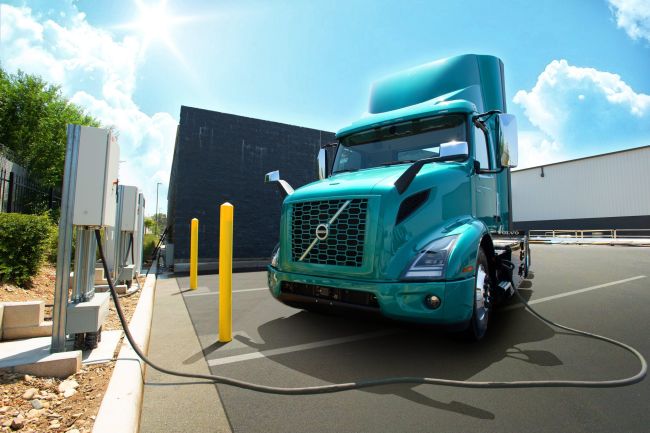
Get Set for an Electric Chain Reaction
Get ready for a two-pronged electric surge. As utilities seek to cut emissions and fuel use while boosting their sustainability goals via fleet electrification, two developments out of Washington D.C. should lead to (1) faster rollouts of electric trucks purpose-built for vocational and on-highway applications and (2) building substantial corridors of truck-charging infrastructure along key commercial corridors.
First and foremost is a new final rule on greenhouse gas (GHG) emissions limits issued in late March by the U.S. Environmental Protection Agency. Specific to model-year 2032 and later heavy-duty on-highway vehicles, the rule phases in as early as model-year 2027 for certain vehicle categories. Known as the Phase 3 GHG rule, it sets new carbon dioxide (CO2) standards for heavy-duty vehicles.
The Phase 3 standards refine the EPA’s Heavy-Duty Phase 2 rules from 2016. The standards are technology-neutral and performance-based, allowing each manufacturer to choose what set of emissions control technologies they will deploy to meet the standards.
EPA Administrator Michael Regan explained that the rule also builds on the recently finalized rule for light- and medium-duty vehicles. “EPA’s strong and durable vehicle standards respond to the urgency of the climate crisis by making deep cuts in emissions from the transportation sector,” he said.
Even so, the tighter CO2 limits don’t sit well with every stakeholder group.
The Upshot
Promoting the production and adoption of electric trucks is not the stated goal of the regulation. However, sustainability analysts and trucking lobbyists agree – albeit from diametrically opposed positions – this will be the practical upshot.
Over-the-road trucking’s biggest lobby came out strongly against the new rule. In particular, the American Trucking Associations (ATA) took issue with exactly how neutral the rule is on technology. According to a statement from the ATA, “While EPA’s final rule includes lower zero-emission vehicle rates for model years 2027-2029, forced zero-emission vehicle penetration rates in the later years will drive only battery-electric and hydrogen investment, limiting fleets’ choices with early-stage technology that is still unproven.”
Put a positive spin on that position and you get right to why this new rule will help drive forward the development of battery and hydrogen fuel-cell electric trucks.
Even more telling is the public backing of the new rule by truck manufacturers. That may be due to the realization that pushing back against lower CO2 limits is no longer feasible coupled with the oft-stated sustainability goals of these companies. Not to mention that all heavy-truck manufacturers now operate on a global scale and would like nothing more than to be able to develop trucks with as much certainty as possible in this, their largest market.
For example, Sean Waters, vice president of product integrity for Daimler Truck North America, said of the Phase 3 rule that the transition to EVs will depend on the “availability of reliable zero-emission charging and refueling infrastructure … We appreciate the regulation’s recognition of this fact and look forward to working with the EPA as well as federal and state governments to deliver both.”
On the Road
Besides looking to pick from a larger selection of medium- and heavy-duty electric trucks to begin with and then running the numbers on their comparable operating and lifetime costs versus other powertrain options, seeing charging stations being built beyond those at fleet domiciles is the other great expectation of fleets considering electric power.
What’s more, the same concerns will apply when fuel-cell electric trucks, which will require access to hydrogen filling, start to become more available.
While various industry and private-public efforts are underway to develop EV charging networks, the federal government has now taken a big step to assist with that specifically to benefit the electrification of commercial vehicles.
The Biden administration in March rolled out a plan for “an all-of-government approach to aligning investments and accelerating sustainable and scalable deployment of reliable zero-emissions medium- and heavy-duty vehicle [charging] infrastructure.”
Dubbed the National Zero-Emission Freight Corridor Strategy (see https://driveelectric.gov/files/zef-corridor-strategy.pdf for more), this cross-agency roadmap will guide EV infrastructure deployment to meet growing market demand by promoting public and private investment and supporting electric utility and regulatory planning at local, state and regional levels.
Agency officials contend that the strategy will help develop greater and more convenient access to EV charging and hydrogen refueling along the nation’s freight corridors and at truck depots located within key freight hubs.
The strategy aims to “meet freight truck and technology markets where they are today, determine where they are likely to develop next, and set an ambitious pathway” to get there with needed infrastructure. Officials noted that by focusing deployment on areas with substantial freight volume, it will start “deployment in areas with the most opportunity to spark further investment.”
Covered by the plan are a diverse range of Class 4 to Class 8 truck applications. The strategy rests on the concept that as infrastructure increases within freight hubs and connecting corridors, “the opportunity for longer-range transportation to occur between these locations is more likely, catalyzing [EV] market expansion and transformation.”
The strategy is designed to move through four progressive phases to promote zero-emission truck adoption from 2024 to 2027; 2027 to 2030; 2030 to 2035; and 2035 to 2040. To accelerate EV infrastructure at freight hubs and along freight corridors, it will:
- Establish priority hubs based on freight volume (2024-2027).
- Connect hubs along critical freight corridors (2027-2030).
- Expand corridor connections and initiate network development (2030-2035).
- Achieve a national network by linking regional corridors for “ubiquitous access” (2035-2040).
Provided in the 318-page outline of the strategy is a map of what the completed national corridor should look like. It shows EV infrastructure stations plotted along most – if not all – of the nation’s key interstate highways.
About the Author: David Cullen is an award-winning journalist who specializes in covering the trucking industry. Based in Connecticut, he writes for several business publications.

